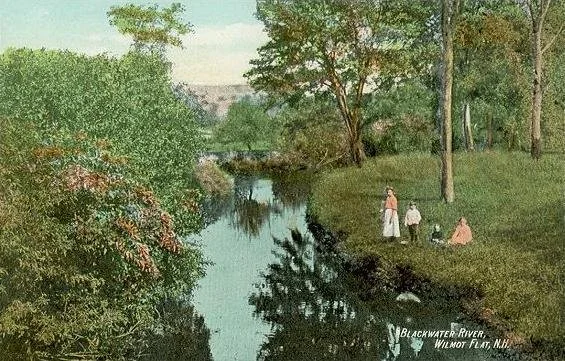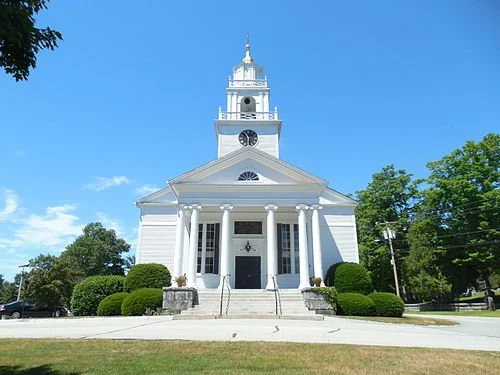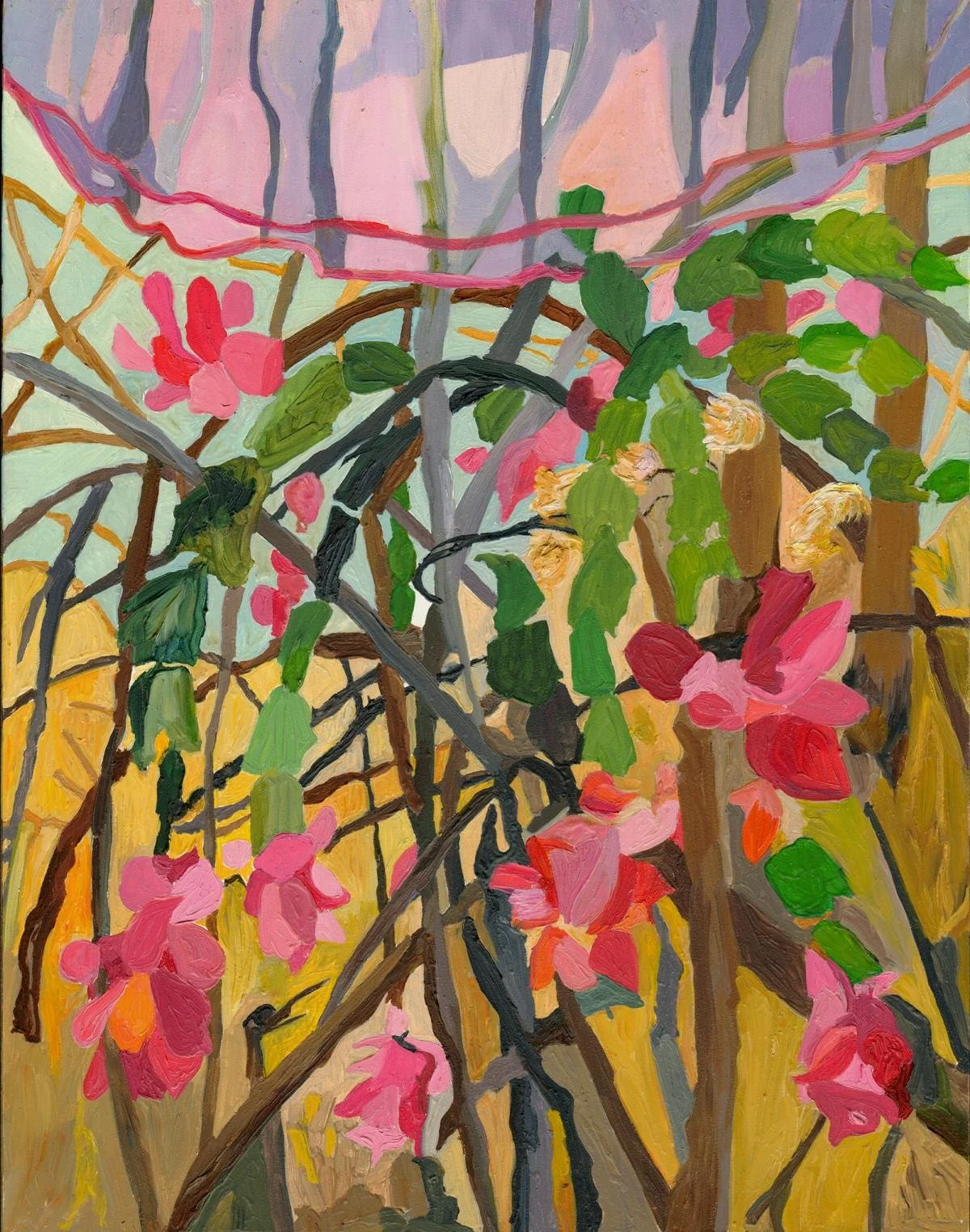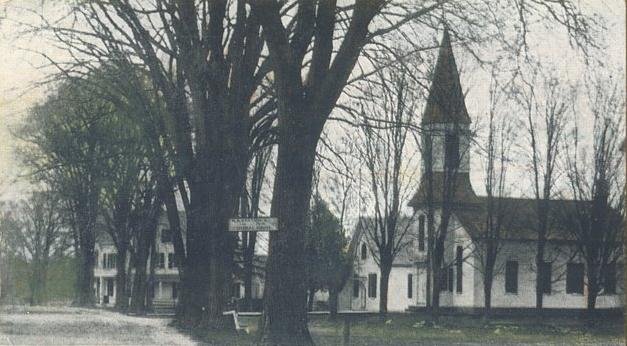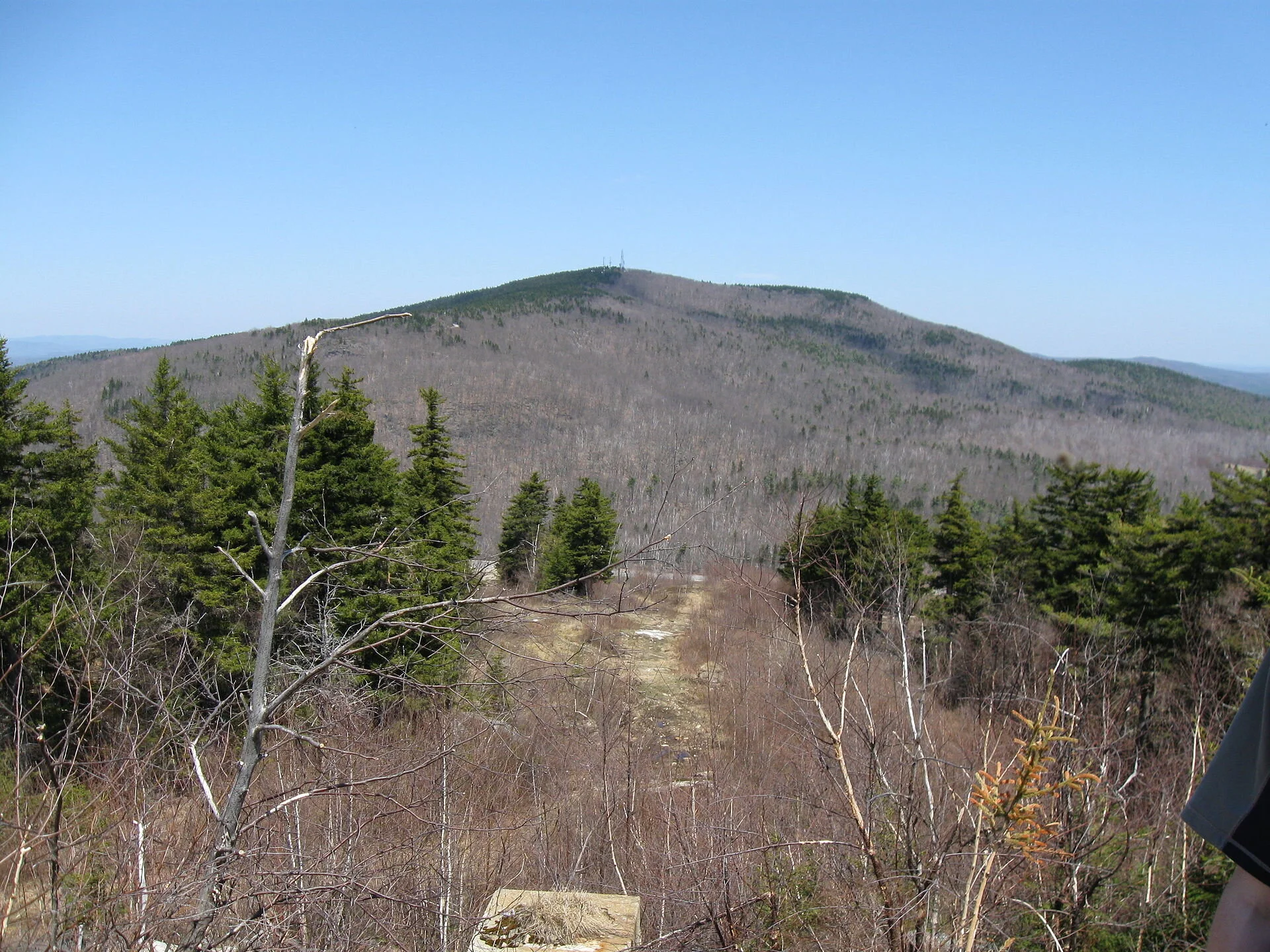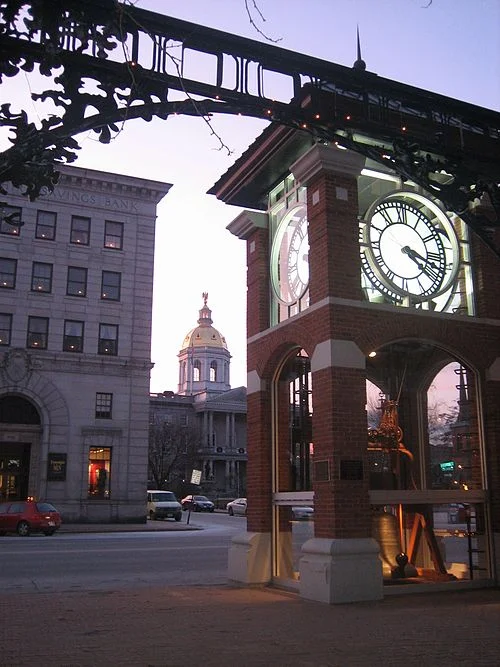
Water rising and receding
This ceramic work is in Judy Pfaff’s current show, “smokkfishkur,” at the Museum of New Art (MONA), in Portsmouth, N.H.
The museum says:
“Judy Pfaff's painting in space takes a step further at MONA. Here are themes here of water rising and also receding, themes of the sea, ice, especially Icelandic—smokkfiskur, the Icelandic word for ‘squid,’ serves up mysteries that hint at submerged life counterbalanced by life made newly visible….
“Life beneath the surface is a long, evolving theme of Pfaff's. Here, for the first time, she includes new exploration of ceramics. Collapsed and twisted, these pots merge with sea life relics as exposed marine sedimentary layers similar to the palimpsest play in her printworks….
”Water is changing our world. Sea levels are rising; arctic lakes are vanishing. This upwelling of ancient history and covert creatures also stokes joy and curiosity. While the front gallery displays undersea emergence, the middle gallery invites emotional immersion served up and brightly lit with ingenious imagination. The rear gallery teases with secrets. Here, above sea level, there are hints of glaciers and things that float, bleached by the sun or frozen and preserved.’’
It must have SOME use!
“A man was cleaning the attic of an old house in New England and he found a box that was full of tiny pieces of string. On the lid of the box there was an inscription in an old hand: ‘String too short to be saved.’’’
— Wilmot, N.H.-based poet and essayist Donald Hall (1928-2018) in String Too Short To Be Saved
Godine, the book’s publisher, notes:
“Donald Hall’s memoir of boyhood summers on his grandparents’ small New Hampshire farm has joined the pantheon of New England classics.
“Hall’s prose brims with limitless affection for the land and its people, but String Too Short to Be Saved it isn’t mere nostalgia. These are honest accounts about the passing of an agrarian culture, about how Hall’s grandparents aged and their farm became marginal until, finally, the cows were sold and the barn abandoned.
“But the story of Eagle Pond Farm continued when Hall returned in 1975 to live out the rest of his life in the house of memories and love and string too short to be saved.’’
Blackwater River in Wilmot, N.H., in 1910.
Oh come on! There were others
Bedford(N.H.) Presbyterian Church
“We had no religion at all, but we were Jews in New Hampshire, and my sister – who is now a rabbi – said it best: We were, like, the only Jews in Bedford, New Hampshire, as well as the only Democrats, so we just kind of associated those two things together. My dad raised us to believe that paying taxes is an honor.”
— Roseanne Barr (born 1952), American comedian and actress
A temporary treatment for SAD
“Christmas Cactus, Winter Light” (oil on panel), by Yvonne Troxell Lamothe, in the show “Beyond the Curve,’’ at Galatea Fine Art, Boston, Dec. 3-Jan. 16
The gallery says:
“{Ms. Lamothe} has been producing both oil paintings and watercolors mainly completed en plein air. Yvonne embraces her roots in New England. Finding intrigue with marshlands, woodlands and glorious vistas of Quincy, Mass., and Greater Boston’s South Shore, where she now lives and her cabin in Ossipee, N.H., and the White Mountains where she finds solitude gives her ample inspiration for painting. Trips to the Maine coast and Vermont offer great additional and endless places to stop and paint. It is no wonder that such a range of American painters have found their way here to New England. Among her favorites are Marsden Hartley, Lois Dodd and Milton Avery. Her paintings show close connections to the earth because of the unusual perspectives that she finds to insure a closeness to her subject. Color is of essence to Yvonne and this joy can be felt in her work. And, of course, as the earth becomes more threatened, she hopes her paintings will inspire others to take time to appreciate and celebrate our planet.’’
View of Marina Bay and Boston across Quincy Bay from Wollaston Beach, in Quincy
Center Ossipee in 1915
In search of cheap help
View of Pack Monadnock Mountain from Temple Mountain, on the eastern side of Sharon, N.H. Temple Mountain was the site of the privately owned Temple Mountain Ski Area from 1938 to 2001, when it was closed. In 2007, the state took it over and turned it into a park. The ski area’s proximity to Greater Boston made it very popular in its heyday, in the ‘50s and ‘60s.
— Photo by Ken Gallager
“I don't mind America becoming a Third World country. The weather is better in the Third World than it is where I live in New Hampshire. And household help will be much cheaper.”
P. J. O'Rourke (born 1947), American writer and satirist. He lives in Sharon, N.H. (population 352 in the 2010 Census.)
'Silly waste of time'
Skiers practicing the “Christiania turn” (aka stem christie).
“By 1920, we had begun to use skis fairly consistently instead of snowshoes at Tolman Pond {in Nelson, N.H.}. A Norwegian family who visited at the farm introduced us to bindings that stayed put reasonably well, and to ski wax and proper poles, and soon we were exploring the magical mysteries of the Christiania turn…. But it was all strictly for fun and nobody dreamed a business might be made out of it. In fact the older generation did its best to discourage us from such a dangerous and silly waste of time.’’
-- Newton F. Tolman, in North of Monadnock (1957)
The Nelson Community Church, with the town’s famous mailbox shelter in front.
Nelson, founded in 1774, was originally named Packersfield, after a founder, Thomas Packer, the sheriff at Portsmouth. But the name was changed in 1814 to honor Viscount Horatio Nelson, British admiral and naval hero. This may seem strange, especially considering that the War of 12812 was underway. But many New Englanders opposed the war and Southern domination of the U.S. government and would have willingly accept a return to British rule.
Nelson, with four streams to provide power, developed into a prosperous small manufacturing town in the 19th Century, making cotton cloth and wooden chairs. That’s long gone and Nelson for many years has been a summer and weekend place. It has long lured writers, such as poet and memoirist May Sarton, and professional and amateur painters.
Sawmill in Nelson, 1914
Opening up
“Connor Pond, Early Spring” (oil on canvas), by Yvonne Lamothe, via Galatea Fine Art online gallery. Connor Pond is in Ossipee, N.H. Ms. Lamothe lives in Massachusetts and New Hampshire.
See:
https://www.galateafineart.com/
and Ms. Lamothe’s site:
A New England paradox
The grand summer resort hotel Wentworth-by-the-Sea, in New Castle, N.H., in 1892
Inside one of the world’s largest factory complexes, the Amoskeag Mills, in Manchester, N.H., around the turn of the 20th Century
“{By the last quarter of the 1800s} tourists sought out the isolated or remote parts of New England, looking for an imagined world of pastoral beauty, rural independence, virtuous simplicity and religious and ethnic homogeneity. In these years, a trip to New England came to mean an escape from the conditions of modern urban industrial life, the very life New Englanders a generation earlier had been praised (and sometimes blamed) for creating.’’
From Inventing New England (1995), by Dona Brown
Martha Bebinger: On a Concord, N.H., street, is it meth or a mental-health problem?
The New Hampshire State House as seen from Eagle Square, in downtown Concord
and WBUR
The dispatch call from the Concord, N.H., police department was brief. A woman returning to her truck spotted a man underneath. She confronted him. The man fled. Now the woman wanted a police officer to make sure her truck was OK.
“Here we go,” muttered Officer Brian Cregg as he stepped on the gas. In less than three minutes, he was driving across the back of a Walmart parking lot, looking for a man on the run.
“There he is,” said Cregg. The officer pulled to a stop and approached a man who fit the caller’s description. Cregg frisked the man, whose name was Kerry. NPR has agreed to use only Kerry’s first name because he may have serious mental health and substance use problems.
“Why were you lying on the ground under a truck?” Cregg demanded.
Kerry, head hanging, rocked back and forth, offering quiet one-line answers to Cregg’s questions. There’s a contest, Kerry said. The prize was a new pickup truck, and he just had to find the truck with a key hidden underneath. He said he had searched three so far.
“Kerry, did you take anything today?” Cregg asked. “You’re not acting right.”
“No, no,” said Kerry, shaking his head forcefully. “I’m just stressed out.”
Cregg watched Kerry, looking for signs — is this meth or a mental health problem? Over the past three or so years, as meth has surged in New Hampshire and across the U.S., it’s become hard to tell. Police in many areas of the country where meth has maintained a steady presence have more experience making an assessment, but in Concord and many parts of the Northeast, the onslaught of meth is new.
Concord police say they need to know whether they’re dealing with a mental-health issue or drugs — or both — because it can make a difference in determining the best response.
Concord may send six to eight officers to subdue someone darting through traffic who is high on meth. The calming techniques these officers learned during training for a mental-health crisis intervention don’t seem to work as well when someone is out of control on methamphetamine. Several officers are recovering from injuries sustained during meth-related calls
“Stay right there for me, all right?” Cregg told Kerry. “I like you too much — stay right there.”
Cregg walked a few steps away from Kerry to speak to one of two other officers called to the scene. It turned out this was the third time in the past few months that alarmed drivers had reported finding Kerry under their car. Cregg decided Kerry’s delusions were mental-health issues and didn’t call for more backup.
Kerry, now cuffed, climbed into the back of Cregg’s cruiser, and they headed for the station. Kerry’s suspected crime: prowling.
“Hey, uh, Kerry — man, you feel like you want to go up to the hospital to speak to somebody?” Cregg asked a version of this question four times.
“No, no,” Kerry said repeatedly, “I’ve been through that route years ago; don’t want to do it again.”
Kerry said later that getting stuck in a hospital emergency room — waiting days, maybe weeks for an opening in a psych treatment program — makes his anxiety much worse.
At the station, Cregg found something that changed his view of the day’s events.
“What is that, Kerry?” Cregg asked, pulling a tiny plastic bag of glistening white shards out of Kerry’s coin pocket. It appeared to be meth. “This explains a lot.”
Cregg said what he thought was psychotic behavior likely had more to do with meth.
But “on that call, they mimicked each other. I wasn’t able to tell at first,” Cregg said.
That may be because Kerry is one of the 9.2 million adults in the U.S. coping with both a mental-health problem and a substance-use disorder. In this particular case, not being able to tell what fueled Kerry’s delusions didn’t cause any problems for him or the police. Things never got out of hand. But Concord Police Chief Bradley Osgood said calls triggered by meth are often more challenging than this one.
“With somebody that’s high on methamphetamine, you want to treat them a little firmer and control them,” Osgood said, “because they often are very volatile and aggressive, and you just want to treat that hostility differently.”
With meth now accounting for 60% of drug seizures in Concord, police say they often default to that firmer approach. Some mental health advocates worry that may mean police are using too much force with their clients. Sam Cochran, a retired major in the Memphis Police Department who co-founded and now helps lead CIT International, a crisis intervention program that includes training for police, said officers aren’t making a diagnosis.
“The officer’s foremost [concern] is ‘How do I open up communications? How do I get compliance in order to accomplish safety?'” Cochran said.
There are visual signs of longer-term meth use that are less likely to show up among mental-health patients: skin wounds and scabs, rotting teeth, dilated pupils. But addiction medicine specialists agree it is difficult to determine what’s going on, at first glance, with someone who appears extremely agitated.
“The possession of methamphetamine may be a clue, but teasing out the acute effects of methamphetamine versus a long-standing mental illness may take a longer period of time,” said Dr. Melissa Weimer, an assistant professor of medicine at Yale School of Medicine. She noted that the effects of meth can last 72 hours or longer.
Surging meth use is relatively new in New England. On the police force, Cochran dealt for years with this issue of meth’s effects mimicking mental health issues. He said slowing things down and diffusing fear can work when dealing with people high on meth.
“But let’s be real, there are some individuals that are so sick,” Cochran said, that “officers find themselves having to act immediately to protect safety. Sometimes that may mean a hands-on approach.”
Cochran and another mental-health advocate, Dr. Margie Balfour, an associate professor of psychiatry at the University of Arizona, say the goal is to only use force as a last resort.
“And then, ideally,” Balfour said, “whether it’s meth or mental health or both … you’re going to be able to take that person to somewhere where they are going to get treatment — and not to jail.”
Balfour is also chief of quality and clinical innovation at Connections Health Solutions. The organization operates a network of psychiatric crisis centers in Arizona where, instead of making an arrest, police can drop off anyone 24 hours a day who is out of control on meth or who has a mental-health condition. Balfour said 20% of adults seen at Connections test positive for meth.
Kerry was due last week in a New Hampshire court where a judge could have ordered drug treatment or an evaluation. Kerry didn’t show up for that arraignment — but said he is trying to reschedule.
This story is part of a partnership that includes WBUR, NPR and Kaiser Health News.
Martha Bebinger, WBUR: marthab@wbur.org, @mbebinger
William Morgan: In a N.H. town, an oasis of high artistic creativity
The MacDowell Colony, a 400-acre artists' retreat in the woods in Peterborough, N.H., represents one of the most notable gatherings of creative energy anywhere. It is a refuge, an oasis, a special place where writers, musicians, and all kinds of visual artists, come to create. It provides, its mission statement declares, “an inspiring environment” in which artists can produce “enduring works of the imagination.” Despite its many famous alumni, MacDowell is successful because it is virtually inaccessible to the world beyond.
Artists, ranging in age from 25 to 80, are “here because they want to be,” says the resident director, David Macy. Competition is fierce for a place to work alone all day in the silence of the forest, in sight of Mount Monadnock. One thousand applications are received for just the summer session. The reputation of MacDowell is such that a MacDowell residency bestows an immediate career boost. (MacDowell alumni have garnered 65 Pulitzer Prizes.) The sole criterion for acceptance is artistic excellence.
Since the colony’s founding, in 1907, by composer Edward MacDowell and his pianist wife, Marian, over 8,000 artists have traveled far from New York lofts and ateliers around the globe (a tenth of the residents are from abroad) to make art there. Around 300 colonists come to MacDowell every year, and are blessed with housing, a place to work, good food, and the precious gift of time. Thirty-two studios provide working space from anywhere from two weeks to three months, but the average fellowship is for a month.
Edward MacDowell's composing cabin.
Thornton Wilder wrote Our Town, which some call the greatest American play, at the MacDowell. Peterborough was apparently a partial model for the town — called Grover’s Corners in the play. Leonard Bernstein and Aaron Copland found the quiet to compose here, while MacDowell provided succor and sanctuary to such writers as Willa Cather, Toni Morrison and James Baldwin. Were their privacy not so carefully guarded, this demi-Eden might have become a magnet for celebrity watchers.
The colony welcomes the public only one day a year when its awards the MacDowell Medal. Medalists have included Edward Hopper, Georgia O’Keeffe, Norman Mailer, Isamu Noguchi, Merce Cunningham and Stephen Sondhiem, among others. In 1997, the colony itself was awarded the National Medal of the Arts, America’s highest honor for an artist or an art patron.
One of the musician’s cabins.
A stay at MacDowell can feel a bit like visiting your favorite grandmother on the family farm. This kind of idyll, however, is hard won. Running a community with 30-some residents at all times, an equal number of staff, and a spread out physical plant requires extraordinary management skills. Despite an endowment, millions of dollars need to be raised every year to keep the colony going. Director Macy, who dropped out of biomedical engineering to go to art school, has been the ideal colony shepherd for almost a quarter of a century.
This is a campus like few others. Colony Hall, the administrative hub and center of post-studio social life (residents have breakfast and dinner here, but lunch is delivered to the individual studios), was repurposed from a late 18th-century barn. Concord, N.H., architect Sheldon Pennoyer renovated the building a decade ago to comply with current building codes. Although reminiscent of the main hall at one’s childhood summer camp, no attempt was made to hide the changes or make it overtly rustic. Pennoyer was also responsible for the recent renovation of a hundred-year-old music studio
Colony Hall.
That same frugal but playful spirit infused the other studios, most of which are scattered deep in the woods; some are in outbuildings and barns. The progenitor was small log retreat that Marian built for her ailing husband. After his death in 1908, she began building a series of non-pretentious workspaces. There are painting studios with high ceilings and lots of light, musicians have pianos, and suitable equipment is supplied for sculptors. The emphasis is decidedly woodsy, and the studios have fireplaces and rocking chairs. All display “tombstones,” wooden tablets inscribed with the names and dates of everyone who has worked in that particular studio.
A tombstone in Alexander studio.
The MacDowells, who met while studying in Germany, had a favorite monastery in Switzerland that provided inspiration for most the most impressive studio. The widow of the noted American portrait painter John White Alexander built this stone “chapel” as a gallery. Although impractical as an exhibition hall, it is now a most sought-after studio, with tall ceilings, exposed beams, and a giant north window.
A major part of the work of running MacDowell is maintaining and updating the mostly early 20th-Century studios; they are in constant use, but they also needed to be made more energy- efficient.Ca
A few years ago MacDowell decided “to combine comfortable vernacular forms with architecturally sophisticated ones,” remarks New York University architectural historian and colony board member, Carol Krinsky. Cambridge, Mass., architects Charles Rose and Maryann Thompson designed an interdisciplinary arts studio, but it awaits funding. Calderwood Studio, designed as a writer's haven by Burr and McCallum Architects, of Williamstown, Mass., is a contemporary tribute to its predecessors. Many of the early cottages were built for summer use and have had to be retrofitted for year-round use. So, Calderwood, a writer’s was built, says Macy, “to be indestructible,” with a two-story high living room and a long view across a meadow.
Calderwood Studio.
The 1926-28 stone library by the fashionable Boston architects Strickland, Blodget & Law is similar in its memories-of-medieval-Europe-style to the Alexander studio. Its single 1,000 square-foot, timber-trussed room outlived its role as repository for colony archives and residents' manuscripts, scores, and paintings. In 2013, a 3,000-square-foot addition by Tod Williams Billie Tsien Architects of New York, designers of the Barnes Foundation in Philadelphia and the Obama Library in Chicago, provided a home for such valuables as a first edition of Willa Cather’s Death Comes For the Archbishop, inscribed to Marian MacDowell. This gem of black Québec granite has been sensitively grafted to the meadow and woods by the equally exceptionable landscape architects, Reed Hilderbrand, of Cambridge, Mass.
Announcing its quiet presence is an outdoor fireplace that stands like an ancient stele, honoring the theme of the studio hearths. The selection committee liked that the design was “both harmonious and deferential to the older building,” Professor Krinsky recalls. It was “beautiful, sturdy outside, calm, light, and expansive inside.”
Outdoor fireplace, original library and new library.
View from the library.
Like the colony itself, the library wears the names of its famous designers lightly. This maybe one of the handsomest pieces of architecture in New England, but it is modestly tucked away, there to reinforce the MacDowell Colony’s role as an incubator of genius.
William Morgan is a Providence-based architectural historian and essayist. He conducted an historic resources study of Peterboro in 1971-72, and is the author, among other books, of Monadnock Summer: The Architectural Legacy of Dublin, New Hampshire.



